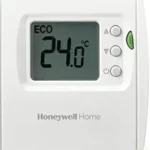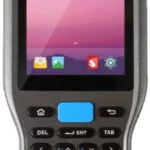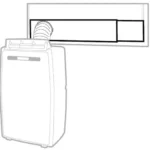
RLV210A1002/U1
Honeywell RLV210 Digital Non-Programmable Thermostat Manual
How do I find out what the voltage is coming into my thermostat?
Honeywell offers thermostats for both low voltage (24 volts) and line voltage (120 or 240 volts) systems. The most common type of voltage from a central heating and/or cooling system is 24 volts (24Vac). The old thermostat may say somewhere on the thermostat that it is for 24 volt (24Vac) or maximum 30 volts (30Vac). If you see 120 Vac or 240 Vac on the thermostat, a low voltage thermostat will NOT work with your system. You will need a line voltage thermostat. This type of voltage is common with electric baseboard heating. Regardless of the voltage, Honeywell strongly suggests that you turn off the power to the system at the furnace, at the fuse, or at the circuit breaker panel before installing or replacing a thermostat. If you are unsure about your voltage, please contact a local heating and cooling contractor in your area for assistance.
How many thermostats can one Portable Comfort Control manage?
One Portable Comfort Control can manage up to 16 thermostats. I am unsure of the voltage coming up to my thermostat. How do I find out? Answer: Honeywell offers thermostats for both low voltage (24 volts) and line voltage (120 or 240 volts) systems. The most common type of voltage from a central heating and/or cooling system is 24 volts (24Vac). The old thermostat may say somewhere on the thermostat that it is for 24 volt (24Vac) or maximum 30 volts (30Vac). If you see 120 Vac or 240 Vac on the thermostat, a low voltage thermostat will NOT work with your system. You will need a line voltage thermostat. This type of voltage is common with electric baseboard heating. Regardless of the voltage, Honeywell strongly suggests that you turn off the power to the system at the furnace, at the fuse, or at the circuit breaker panel before installing or replacing a thermostat. If you are unsure about your voltage, please contact a local heating and cooling contractor in your area for assistance.
What is a resistive load?
A resistive load is typically an electric baseboard heater. In resistive loads, the amperage remains the same throughout the call for heat. Inductive loads are typically seen in a motor load. The motor will pull a greater amount of amperage to start and then will drop significantly once the motor is running. Inductive loads require a thermostat specifically designed for inductive loads. The higher the temperature, lower the resistance.
What is a cycle rate?
Your thermostat is designed to control temperature to +/- 1 F, the cycle rate setting is one factory that helps the thermostat maintain your temperature setting. How often your heat turns on and off depends on may factors including the type of heating system you have as well as how much your system needs to run to maintain your temperature setting (in other words, how cool or cold it is outside). A typical forced air system will cycle about five times in an hour, this is normal. A typical hot water system would cycle less then that. Every heating system type will deliver heat to the house at a slightly different rate. Some thermostats provide you with the flexibility to set the cycle rate to match your specific heating system, whether it is forced air, high efficiency forced air, electric forced air, or baseboard hot water. Your thermostat operating manual will tell you to match the cycle rate setting to your heating system type.
Specifications
Electric Baseboard Heat Non-programmable Thermostat
| Thermostat Type | Line Voltage |
| Program Modes | Manual / Not Programmed |
| Utility Rewards | No |
| Warranty | 1 Year |



